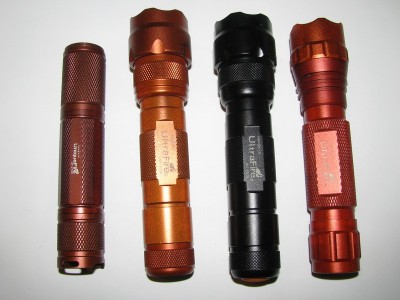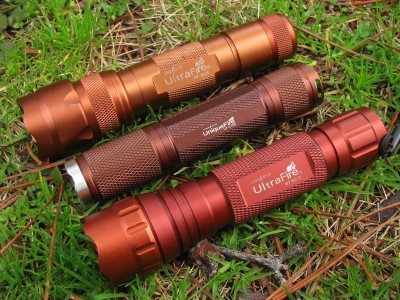Today I was reading a post at Budget Light Forums where a guy baked (broiled, actually) a black flashlight in his oven and changed the color (link). Well, since he told a bunch of other people who also own more black flashlights than anyone could need, soon a lot of people were doing some baking. Some of the lights would turn orange or bronze. Some just turned brown or kind of purple. So naturally, it wasn’t long before I turned my oven to broil as well. I chose two lights that I don’t really like that much, one of which is an inferior copy of a light I do like. I took them apart and removed all the electronics, switches, o-rings, glass lens, and then put the aluminum parts back together. I tried one of them and it turned kind of purple. So I put the second light in there and then added a third light that I really do like. The color changed within about 30 minutes, though I kept the first one in the whole time to see if it got lighter. They all came out differently. Here is a picture of the three lights plus a control that was not baked.
 The first one is kind of chocolate brown, maybe like an old penny (here’s a post of what it used to look like). The second light looks like it is made from copper tubing and used to look exactly like the unbaked third light. The last light is sort of reddish brown, again maybe a shade of copper but with more red (before). Pretty neat.
The first one is kind of chocolate brown, maybe like an old penny (here’s a post of what it used to look like). The second light looks like it is made from copper tubing and used to look exactly like the unbaked third light. The last light is sort of reddish brown, again maybe a shade of copper but with more red (before). Pretty neat.
Later on a guy posted a video on YouTube where he just puts the light directly on a burner of his gas range and cranks up the heat. Takes about 3 minutes that way. Later on after I put the lights back together, I took this picture. I’m really liking the way these turned out. Each one has a distinct color.

That’s amazing, and a bit random. I gather all of the result colors are acceptable to guys… grunge / earth kinds of colors vs. pink or mauve. Will they now just stay that color? If you chipped away at it, would it be aluminum below (and I guess that might be the same for the black)?
The colors should be stable now and it doesn’t seem like it is more likely to chip off. It isn’t paint, but anodizing which means they oxidize the surface of the aluminum and then apply dye to get it black. The natural color of the anodizing can be tan or army green and I think what is happening is some of the dye is burning off. People seem pretty okay with the colors (most lights only come in black, so if you have a lot of lights it is good to get some variety) and I liked them a lot. I got a couple of comments from people at BLF saying they liked the small brown one. And the copper one is pretty neat: one guy made his own light out of actual copper that people raved about. The thing people don’t like is that some parts of the light will turn out a different shade than other parts. There is a more involved project where people will remove the anodizing entirely with chemicals, then buff and polish the bare aluminum for a super shiny light. One guy baked his and then removed the anodizing and said the baked anodizing was harder to remove.
That’s really cool. Amazing that people experiment with things like that.
I tried the same, nice bronze color, but one can see the anodized coating is now ‘shattered’ (one just has to catch it right in the light to see the crazed effect.